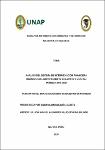Análisis del sistema de intermediación financiera indirecta del departamento de Loreto y Ucayali periodo 2015-2020
Abstract
The objective is to compare the indirect financial intermediation system of the Department of Loreto and Ucayali, period 2015-2020. The type of research is of a descriptive level and a quantitative approach, with a non-experimental research design, of a comparative descriptive longitudinal type. The population is finite, it was made up of 14 financial entities from Loreto and 15 from Ucayali, the technique was the census, of intentional non-probabilistic sampling. The collection technique was documentary analysis, and the instrument was content analysis, with an interval scale. The result of the first dimension, it was proved that there is a significant difference between the behavior of the deficit agents between the Departments of Loreto and Ucayali. The second dimension, it was proved that there is a significant difference between the behavior of surplus agents between the Departments of Loreto and Ucayali, the third dimension, it was proved that there is no significant difference between the delinquency rate of the Departments of Loreto and Ucayali, and the last dimension, it was proven that there is a significant difference between the evolution of the financing deficit of the Department of Loreto and Ucayali, period 2015-2020. We conclude that there is no significant difference between the indirect financial intermediation system of the Department of Loreto and the Department of Ucayali, in the period 2015 to 2020. El objetivo es comparar el sistema de intermediación financiera indirecta del Departamento de Loreto y Ucayali, periodo 2015-2020. El tipo de investigación es de nivel descriptivo y enfoque cuantitativo, con diseño de investigación no experimental, de tipo longitudinal descriptivo comparativo. La población es finita, estuvo conformada por 14 entidades financieras de Loreto y 15 de Ucayali, la técnica fue el censo, de muestreo no probabilístico de tipo de intencional. La técnica de recolección fue el análisis documental, y el instrumento fue el análisis de contenido, con escala intervalo. El resultado de la primera dimensión se probó que existe diferencia significativa entre el comportamiento de los agentes deficitarios entre los Departamento de Loreto y Ucayali. La segunda dimensión, se probó que existe diferencia significativa entre el comportamiento de los agentes superavitarios entre los Departamento de Loreto y Ucayali, la tercera dimensión, se probó que no existe diferencia significativa entre la tasa de morosidad de los Departamento de Loreto y Ucayali, y la última dimensión, se probó que existe diferencia significativa entre la evolución del déficit de financiamiento del Departamento de Loreto y Ucayali, periodo 2015-2020. Concluimos que no existe diferencia significativa entre el sistema de intermediación financiera indirecta del Departamento de Loreto y del Departamento de Ucayali, en el periodo 2015 al 2020.
Collections
- Tesis [7]


